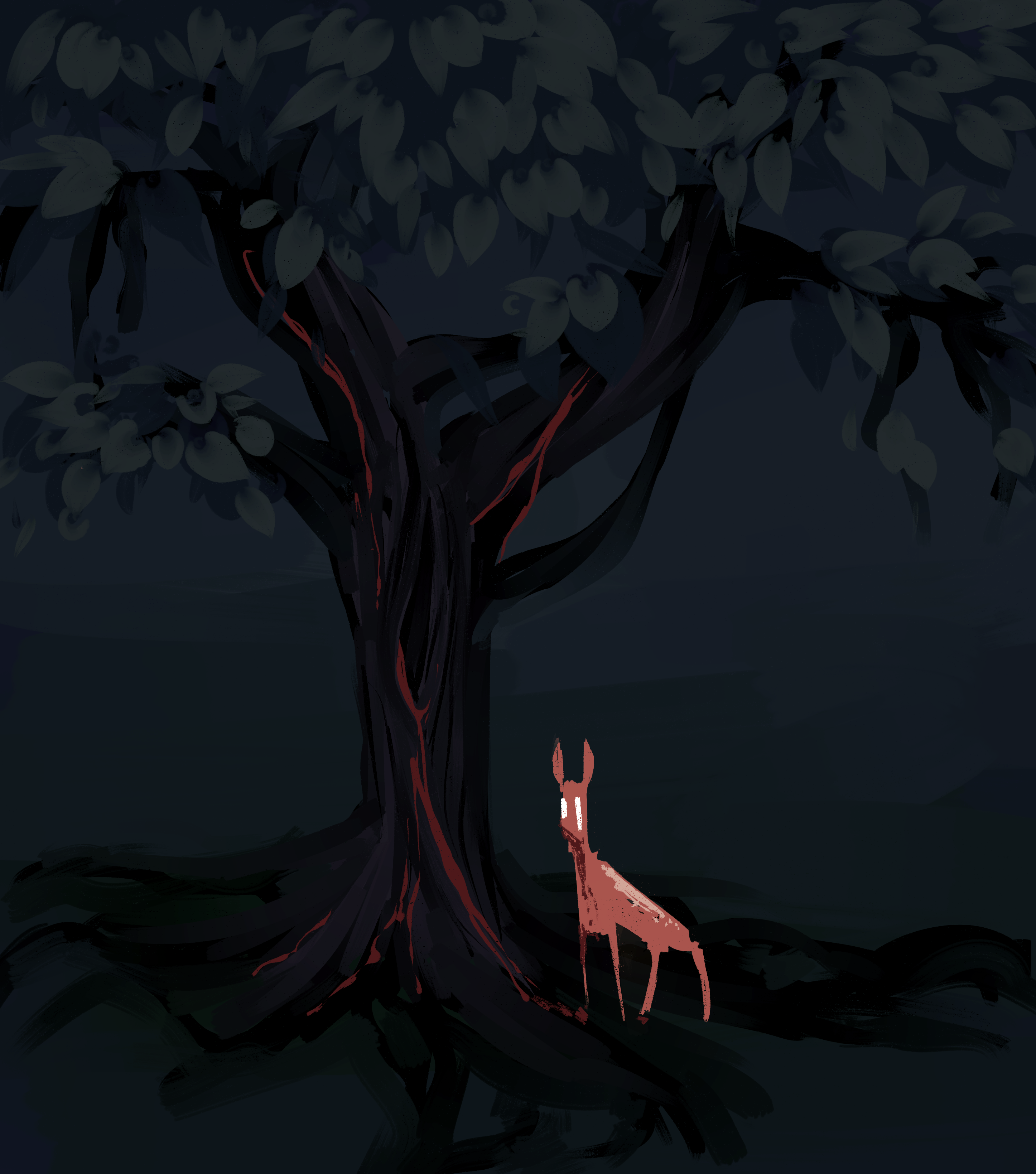Bloodsap Tree

Bloodsap Tree by Leviathx
Lifecycle of a Bloodsap Tree
1. Capturing Prey
It begins with an uhaaki. When one of these creatures has caught its prey, it doesn't eat them. Instead, the paralyzed creature - a deer, a wolf, a human, or any other large mammal - is carried through the woods until the uhaaki finds an appropriate place to grow a new tree.2. Planting
The victim is impaled through the abdomen with the large, spiked seed pod of the bloodsap tree. The tree swiftly spreads its roots. By the time the venom wears off in around 12 hours, the seed has not only rooted itself into the ground, but also spread its roots into the intestines of its victim. Ripping the plant out at this point would lead to rapid death via blood loss. At this point, the victim is incapable of freeing themselves from the tree. The longest a person has been successfully rescued by a comrade after being planted is 20 minutes. Official protocol in the Border Rangers is that if you find a comrade planted, you are to slit their throat to give them a quick death. The slim chance of successfully saving them is not considered worthwhile compared to the high risk of the one doing the saving also falling prey to an uhaaki still in the area. However this protocol carries no penalty for defying it, because those that find themselves in such a grim position have the right to do for their friend what they feel they must.3. Growth
The tree feeds on the blood of its victim, using it as nutrients in its growth. The spread of the roots plug the wounds to prevent death. As it grows and begins to produce sap, it delivers sugars and fluids directly into the intestines to prolong life. As the tree grows, so too does its lua. The roots reach further into its victim, sucking up the lua along with the blood. The lua of the victim becomes entangled with that of the tree, and as the tree grows stronger, its grip on the victim's lua grows firmer. With the lua unable to escape, the victim is unable to die, and their continued life produces fresh blood for the tree to gorge upon.4. Amalgamation
Throughout its growth, the victim's lua, with its panai tied to it, is pulled more and more into the tree. It merges with the lua of the tree in an unbreakable bond, like metals melted together. After 3 months, more of a victim's soul is within the tree than their body, and their body begins to wither. At this point, the tree has consumed enough of the victim to no longer depend on it for nutrients. The tree has had time now to adapt to whatever environment it was planted in, and its roots are firmly in the earth below and around the victim. It can begin weening itself off the blood of the victim, and take in nutrients through the soil and sunlight. By 6 months, the soul of the victim is fully consumed by the tree. The body at last dies, while the soul is twisted and combined with the soul of tree.5. Maturity
Once the victim is dead, a tree has reached its maturity. The corpse decays into bones that eventually get swallowed up in the mess of roots around a tree's base. They will now begin growing their own seeds. Typically, a single tree produces around 5 seeds during a year, which grow from late spring and through the summer. They hang from branches like abnormally large pinecones. In fall, the seeds are fully grown and ready, and fall to the roots where they are gathered by roaming uhaaki. Uhaaki swallow the seeds into a pouch near their stomach, where they can remain dormant for up to ten years until a new victim is captured to be planted. A tree reaching maturity also means it will begin producing large quantities of its distinctive blood-red sap, which oozes from the tree when cut. The sap is the primary food source of uhaaki.Appearance
Bloodsap trees are deciduous. They continue growing throughout their lives, with some trees centuries old and so massive they could be used as a house if the trunk were hollowed out. The gnarled trunk is covered is rough, dark-grey bark. Most trees have slashes criss-crossing their trunk with old sap stains oozing below - remnants of previous uhaaki feedings. The top of their roots are exposed, making the tees appear to be sitting on a nest of twisting roots. Sometimes, bones can be seen sticking out in gaps between these roots. Its leaves are small, about as long as a human palm, and come to a narrow point. Leaves are a faded green colour even at the height of summer. Common belief holds that you can tell which trees where made with a human victim, because the trees grow in a vaguely human shape. The branches reach upward like writhing arms, and if you look closely, you can make out a face within the whirls of the trunk, screaming.
Genetic Descendants
Lifespan
Unknown, but > 125 years
Average Height
20 feet

